"Two aspects of Kim's personality can be seen in her work. One describes the self and the other is the role that the self performs. What Kim's work obviously shows us is not only the perception and exploration of the self, but the perception and exploration of the world through the self's performance. Kim's work can be considered typically modern, seen from the perspective of the perception and exploration of the self, but it is also typically postmodern if seen from the perspective of the perception and exploration of the world. In terms of material and method, however, her work can be seen as a gongpilhwa, that is, a painting done very carefully and precisely with the utmost care for details, and she relies on typical traditional idioms. With this, we can understand that Kim's work breaks down the boundaries between tradition, modernism and post-modernism. We may harbor suspicions against this classification, but Kim's paintings herald the arrival of a new style."
The above is a review by Peng Feng, a Ph.D candidate at Peking University and curator of the Chinese Pavilion at the 2011 Venice Biennale. He was speaking about the works of young Korean artist Kim HyunJung.
Kim didn't receive a regular or typical arts education. Instead, she immersed herself in self-study. She enjoyed drawing and painting all by herself, and from an early age she was good at copying what she saw. There is a saying in Korean that smarts can be beaten by effort, but if you have fun, you will always win. She is the winner.
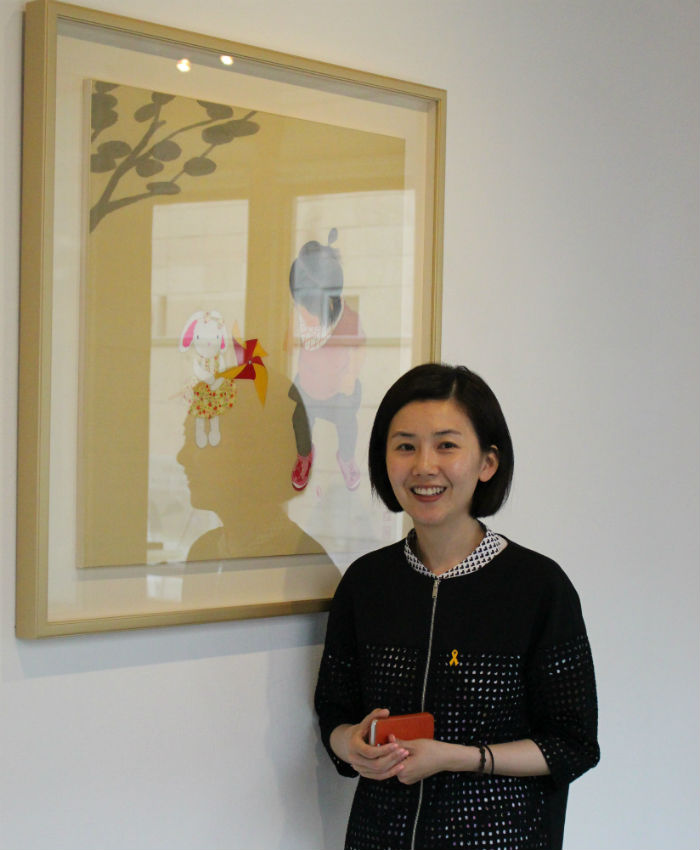
Kim HyunJung unveils her first solo exhibition titled Depiction & Performance at the ArtLink Studio. (photo: Wi Tack-whan)
Her youth was spent far from art or drawing. She made her debut as a model at the age of 20 and has made appearances in a few soap operas and movies since then. Somewhere in her heart, however, she always had a passion for the arts. It might have been boiling beneath her subconscious.
When she was older, she decided to pick up her brush again. After five years of hard work, Kim now finally unveils her first solo exhibition. With the title “Depiction & Performance,” the exhibition opened on June 23 and continues until July 17 at the ArtLink studio in Insa-dong, Jongno District, in central Seoul. It is gaining more and more attention, as it is seen as an exhibition with an exotic theme and a creative technique.
Kim was an actress, featured in a number of shows. Two of the most famous were "Butterfly," a theater production that deals with the issue of enforced sex slaves during World War II, and the other was a soap opera, "My Lovely Sam-Soon."
Her transition from actress to artist seems very special. In 2009, after spending ten years as an actress, she decided to stop everything due to depression, and received psychological counseling. As part of the therapy, she was introduced to her inner child, which Kim associated with her toy rabbit, Lala. Today, she carries the toy with her everywhere she goes.
The feelings and emotions that she believed to have shared and communicated with Lala are all translated onto the canvas and are now finally on display at the exhibition. Lala, so to speak, is featured in this project as another side of Kim HyunJung's character.
In addition to the visualization of an inner child, two particular techniques are featured throughout her work. The first is that she decorates the works with some embroidery on top of the important parts of the drawings. Second, she attaches silk fabric over her drawings, allowing the ink to ooze out naturally.
Kim studied and read everything on which she could get her hands. It ranged widely, from history and theory all the way to art appraisal. The techniques and styles she uses are considered to be something never tried before by anyone else.
A total of 15 works of art are on display at the exhibition. There is "Baguette Cross," a painting inspired by a story from World War II that tells about children in a shelter and their hunger pangs. Also on display is "Lala and a Statue of a Girl." This picture pivots around the issue of the enforced sex slaves. The exhibition is also showing "Summer Colors," a work that shows beautiful summer days, surrounded by lotuses and dragonflies, as well as "Painting of Grass and Insects," completed with golden powder scattered across the dark black canvas.
Korea.net recently sat down with Kim HyunJung to learn more about her short, yet complicated, career as an artist, as well as her life.
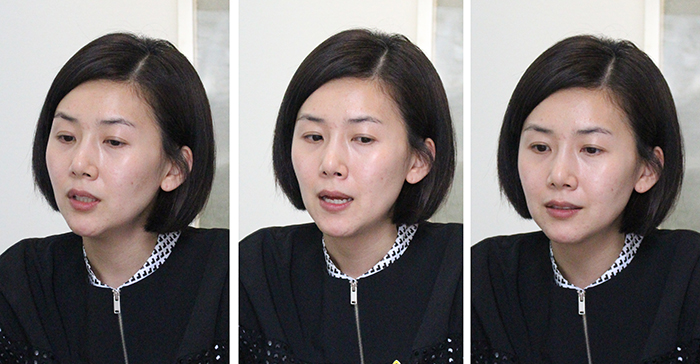
We have seen a number of actors and actresses who can draw. We call them "multi-tainers." It seems even rarer to see an artist who can act, draw and write. You are only in your 30s. Where do you get such inspiration?
Working as an actress, I developed an interest in my inner self. It was especially during the time I was acting for "Butterfly," a theater performance that centered on the story of so-called "comfort women," which were in fact enforced sex slaves for the Japanese military during World War II. The play was dark and heavy. Taking part in it, I had to carry my role for as long as three years. Influenced by that, perhaps, everything in the world seemed dark and cruel to me. Plunged deep into agony, I found myself looking at the darker side of the world and had trouble with my daily life.
Moreover, one of my larger weaknesses as an actor was that I couldn't show my inner emotions. One day, my acting advisor pointed out the weakness, saying that I wasn't able to show anger. It came as a great shock to me. I was overwhelmed and suffered at the thought that I didn't even have the basic skills to be an actress. I had to take an interest in and learn how to present what was inside of me.
The toy rabbit Lala seemed to have an enormous influence on many aspects of your life. What is Lala to you?
I had a chance to register for a voluntary psychological consultation, run through the Roman Catholic Church, known to be useful for people with depression. In the early stages, I thought I would be able to help my colleagues and other people dealing with the same problems. As I learned more and more, however, I discovered that my inner self had not matured and that it is still in need of care.
When I was young, I didn't have the chance to play with any toys. I had to always give them up for my sister, two years younger than me. These memories were brought back again through the consultation. I remembered that I always mumbled to myself, saying, "It's ok. I don't like toys."
After the session that brought back those memories, I decided to get a toy of my one, just for me. Visiting a toy store over the age of 30 was kind of difficult. At the toy store, I made eye contact with my rabbit, Lala. She's a small and trivial thing, but to me, it came as a great joy. I was filled with pleasure and excitement.
Today, we see a great number of people seeking psychological counseling or in search of places that can help heal their mind and soul. I wanted to tell them that it really is a sure way to heal yourself, that you look straight at your immature, inner self. That's how I came to draw and write, to deliver this important message.
It seems creative that a rabbit shows up in traditional Asian paintings. Where did this come from?
Whenever I draw, Lala sits next to me. Staring at Lala, I keep asking myself, "What do I feel here?" or "What do I want to tell people with this?" I ask, and then I answer. It's only questions to myself. I say what I want to say and I express what I feel through my little rabbit.
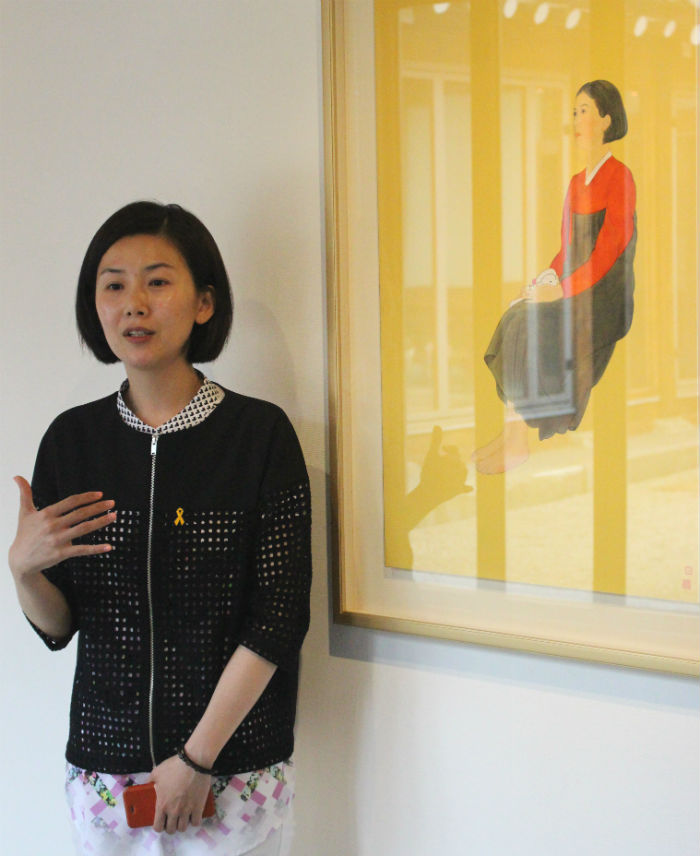
Kim explains about her Lala and a Statue of a Girl. (photo: Wi Tack-whan)
Sharing the words in my mind with other people comes to me naturally. I am just trying to express and share it with as many people as possible, in a variety of manners. In the middle of all that, Lala comes naturally into my drawings. I hope my work can comfort the hearts of the people out there.
In your work, we see an emotional and complicated psychology. Is that what you intended?
There was a time when I took an interest in expressing emotion. I learned about a Chinese artist, Badashannren, thought to have lived from 1625 to 1705. He was of noble lineage, being a descendant of the Ming Dynasty prince Zhu Quan. He expressed anger and rage in his paintings. Studying his work helped me to contemplate and study ways in which I could express anger in a healthy manner. As I started showing in my art everything I had on my mind, I became a lot healthier, too.
When I was young, I had to change schools a number of times because my mother wanted me to get a better education. I didn't have the opportunity to make friends. In addition, as an older sister, I was unconsciously forced to be mature. Everyone has an inner child of their own. It is the weakest and most immature part of me that I wanted to hide. An inner child exists naturally in everyone. I wanted to tell people that it is an important part of yourself that needs to be cherished. I really hope that these types of psychological topics will get more spotlight in the media.
You both act and draw. Are they different?
I was always told from my early years that I was good at drawing. I was especially confident at catching details. I enjoyed drawing because I liked to be praised, but I didn't have the opportunity to get a proper arts education. When I was 20, I debuted as a model. I was cast in a jeans commercial for the brand Storm. In 1999, I played the role of Jindallae in the KBS soap opera "Gwangkki." Acting was fun, too.
Acting and drawing share subtle similarities. First of all, both pursue communication with the public. The two also have in common the fact that we have to refine and trim the message before release. Also, my desire to express my feelings in a more skilled way is a shared similarity, too, I think. I want to communicate with more people through my writing, drawing and performances.
You only began to study drawing in 2008. How were you able to understand and be attracted to the works of Chinese master painters, such as Qi Baishi and Li Keran?
Once at church, I ran into Lee Dong-cheon, a certified appraiser of paintings and a guest researcher at the Museum of Liaoning Province in China. He advised me to elaborate on what I already have before learning new things.
The painter Qi Baishi (1864-1957) was born into a poor family. He was good at literary painting and wanted to study more, but couldn't afford it. Moreover, he was weak and constantly ill. He worked as a carpenter until over the age of 30 and only started studying the arts later on in life. In his autobiography, he noted that he wasn't able to get a professional education, but that he was talented at copying things. I, too, am very good at copying things. When I was young, I copied a picture of the Seokguram Grotto from an image in a textbook. In my mother's eyes, it was so perfect that she kept it to this day. Lee encouraged me to keep studying and advised me to learn more about Qi's world of art.
Li Keran (1907-1989), an apprentice to Qi Baishi, was successful in taking over where Qi left off. I read his "Theory of Painting." I was surprised at how similar it was with acting. I was very much sympathetic to the importance of the truth and to the sincerity he stressed. I cried a lot reading the book. I came to have faith that, now, I was able to penetrate people's hearts.
Do you feel a special attachment to any of your work?
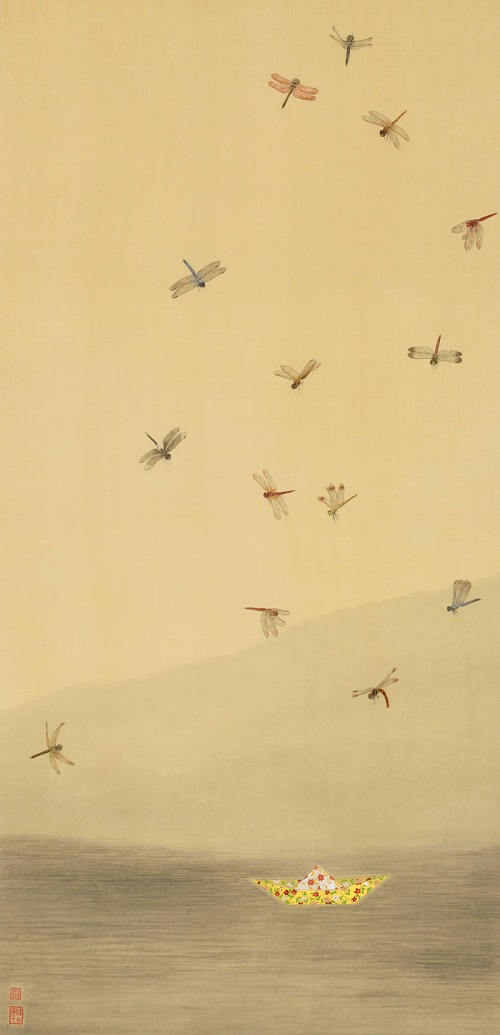
Heaven of Dragonfly
I want to pick three. First is "Heaven of Dragonfly." I made use of a special technique all of my own. I put embroidery on top of my sketches, on the paper. I was able to invent the technique all by myself, as I majored in traditional clothing at university. To use this method, the work needs to be done all at once. It was hard, sitting in one position for such a long, long time. The more effort I put in, the more attached I became to the final product.
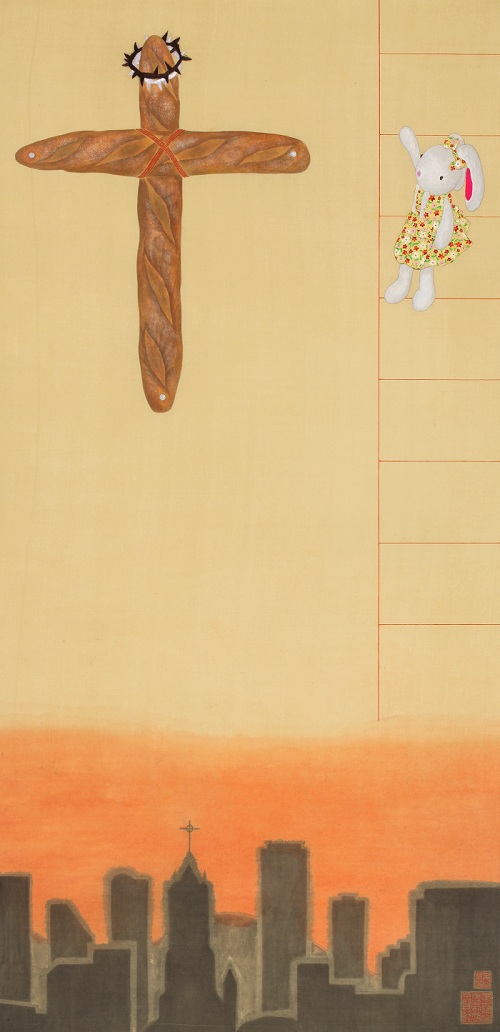
Baguette Cross
Second is "Baguette Cross." It has an important message about raising your inner kid. I was inspired by a story from World War II. Children in a shelter couldn't get to sleep because they were worried they would be hungry the next morning. Adults offered them some bread at their bedside and they were finally able to fall asleep. I so much agree with that, that a small word of comfort or some condolences, or even a brief break, can result in more confidence and a positive attitude in people. My theory is well reflected through this piece.
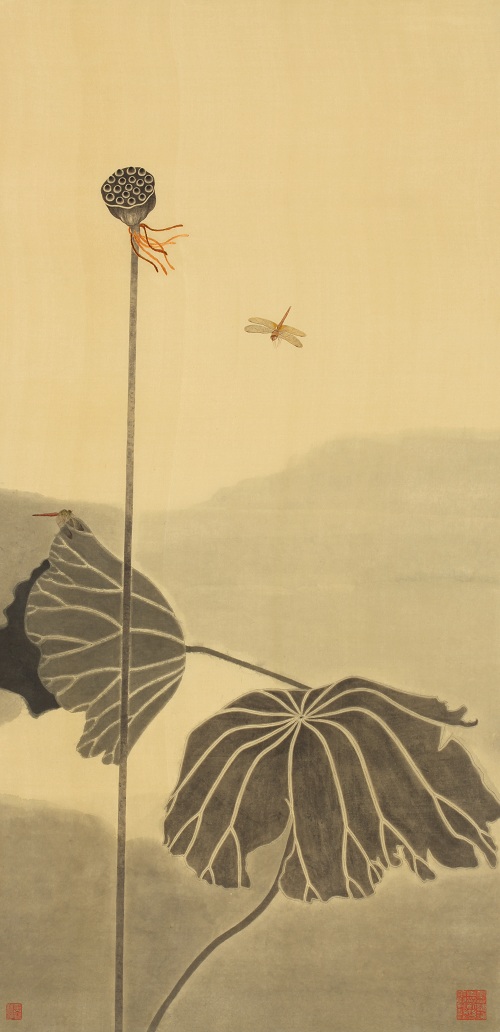
Already Fall Breeze
Finally I would like to introduce my "Already Fall Breeze." As an actress, I am at a turning point. I can no longer play the young and glamorous roles that I used to play in my 20s. Instead, I want to feel and express the beauty of aging and falling down. I painted a flower falling down and all the petals blowing about. It took a long time to map out this sketch.
This is your first exhibition, but it seems very well thought out and quite slick. What is your plan?
When I was acting, after giving a successful performance, I would have the desire to do even better next time. It would almost be a burden to me. I feel the same way now. Through my role as an artist, I want to give the public things to enjoy and from which they can take pleasure, as well as things that help them to learn and think.
This coming November, I am planning to hold the "Three Travel Together" exhibition along with Painter Lee WalJong, featuring some outstanding works of Paik Nam-june. I am putting most of my energy into this project. I feel very honored that I can join hands with those two famous painters to put on our show in China. I will concentrate on that over next few months.
By Wi Tack-whan, Lee Seung-ah
Korea.net Staff Writers
whan23@korea.kr
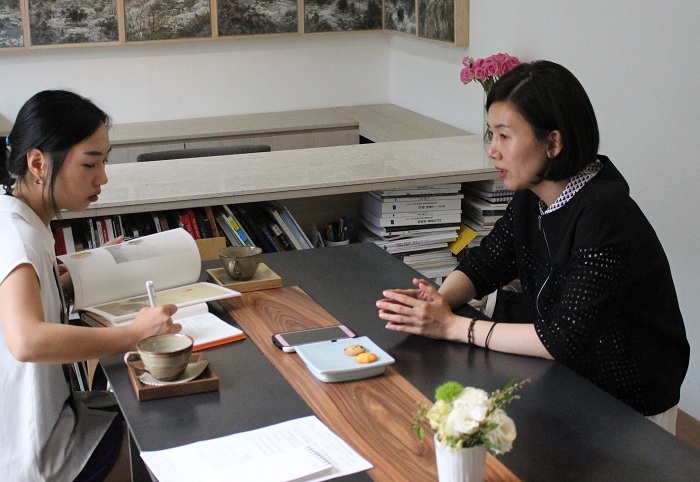
Kim tells about her life as an artist and an actress. (photo: Wi Tack-whan)
Gallery information : 02-738-0738
Kim HyunJung's blog : http://khj_lpe.blog.me